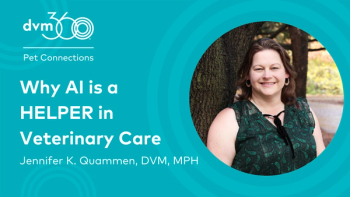
Tunnel vision stunts good medicine
As always, we need to communicate as thoroughly as possible. Tunnel vision is a trap we as practitioners must avoid.
I was in veterinary college when I first heard the phrase "tunnel vision." This term refers to forming an opinion based on the first information we receive, and then being blinded to other information, as if we were looking through a tunnel at the final conclusion. Tunnel vision typically strikes when a client or patient presents a familiar signalment, and we then jump to a diagnosis without considering all of the information.
I found myself guilty of tunnel vision recently on Bill's farm where I started providing nutritional consultation a few months ago. The conversation went like this:
Bill: "I think I may be under-dosing the coccidiostat in my calves. They are not growing well and have loose manure."
Me: "How much do you give them?"
Bill: "I mix a double handful into the grain before I feed them."
I thought this was an easy question to answer. I carry an electronic scale in my vehicle, so I got it out, had Bill put "a double handful" in a container and determined how much he was providing.
A few more minutes with a calculator showed that he was giving roughly half of the recommended dose of the product.
We discussed the implications of this and moved on to a new subject.
When I returned to this farm the following month, Bill noted the calves were still not doing well and asked about changing to another coccidiostat. We considered this a few minutes, and I suggested that we go look at the calves, which were housed on another farm. We did so and confirmed that they looked bad. I then asked more questions about what he fed them, and soon realized the problem went beyond the coccidiostat.
Bill feeds a total-mixed ration to his lactating cows and provides a top dress to his highest producers.
I do not encourage this practice, but it is Bill's preference. When I first started working with Bill, he was using a standardized formula as the top dress. After looking at that formula, I realized I could make changes that would reduce the price and improve the value of the product when used for high producers. To do so, I added some animal protein and some urea while removing selenium as well as vitamins and minerals that were adequately supplied in the total, mixed ration (TMR).
The lactating cows seemed to respond well to the new top dress feed, and Bill was satisfied.
However, Bill and I failed to communicate on one issue. In addition to using this feed for his high producers, he also fed it to post weaning calves — the very same animals that were now looking bad while we had focused our attention on the coccidiostat.
While my formula for the top dress was fine as a supplement for high-producing cows, it was grossly inadequate as a calf grain. It had no vitamin A or D, selenium or trace minerals and far too much urea for this age of animal. No wonder they did poorly.
Tunnel vision had kept me from finding the problem with the calves when Bill first raised concern.
He identified under feeding the coccidiostat as a possible explanation. I zeroed in on that possibility, confirmed that he was indeed underdosing it and failed to look beyond that for other additional causes.
Widespread influence
Tunnel vision is not limited to nutritional problems. When I was in high school, I rode with a local practitioner. One day he was asked to examine a lame cow. It showed classic signs of foot rot, and the doctor prescribed an antibiotic. Three days later, we returned because it was no better.
At that point my mentor lifted the foot and trimmed the sole, and found a nail imbedded deep into the sole, penetrating to soft tissue.
The same occurs when we examine a fresh cow off feed and stop our examination when we hear the ping in the left para-lumbar fossa.
My shortcoming on Bill's farm actually went beyond tunnel vision and included not knowing the diets of all the animals on the premises. If I had taken the time to ascertain how he fed all of his animals, I would have known that he fed top dress to weaned calves and would have addressed that fact when I re-formulated that product.
Lesson learned
Fortunately for all involved, the calves responded rapidly to the appropriate grain mix. Bill graciously shared responsibility with me, and the damage was minimized.
But the lesson is still valid. We need to be thorough when we investigate disease, whether a single animal is involved, a group of five or a herd of 2,000. As always, we need to communicate as thoroughly as possible. Tunnel vision is a trap we as practitioners must avoid.
Dr. Gardner is the business development manager for Agway Feed & Nutrition in eastern Pennsylvania. He also consults with dairy practitioners regarding practice management.
Newsletter
From exam room tips to practice management insights, get trusted veterinary news delivered straight to your inbox—subscribe to dvm360.






